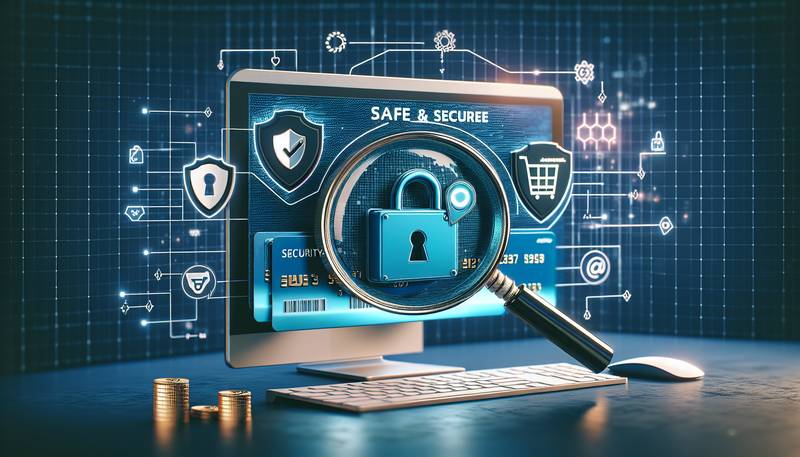Tips for Safe and Secure Online Shopping

Introduction
Welcome to our comprehensive guide designed to empower your online shopping with the best safety practices. As digital storefronts continue to sprout up across the web, the allure of finding everything you need with just a few clicks has never been greater. However, the convenience of online shopping brings with it the need for increased vigilance. Cyber threats and crafty scammers have turned the internet into a battleground where unsuspecting shoppers are the prey. Fear not, for we're here to arm you with an arsenal of tips and tricks to safeguard your online shopping adventures. From navigating through the sea of online retailers to the final moments of checkout, we've got you covered. Let's turn the tables on those cyber threats and make your online shopping experience as secure as it is enjoyable!
Choosing the Right Websites
The foundation of secure online shopping is knowing where to shop. Not all e-commerce sites are trustworthy, and distinguishing the legitimate from the sketchy is crucial. Start by looking for "https://" at the beginning of the website's URL, which indicates a secure connection where your data is encrypted. A small padlock icon next to the URL is also a good sign. Be wary of deals that seem too good to be true - they often are, and could lead you to fraudulent sites designed to steal your personal and financial information. Always do your homework; read reviews about the seller and ensure they have valid contact information. Reputable retailers typically have robust customer service channels should you need to reach out. Stick to well-known websites or recommendations from trusted sources, and when venturing into unknown territory, proceed with caution. By being selective about where you shop, you're building a strong first line of defense against online threats.
Creating Strong Passwords
Passwords are the guardians of our online presence, yet many of us still opt for weak, easy-to-remember combinations. It's time to change that. A strong password acts as a formidable barrier against unauthorized access to your accounts. Avoid using easily guessable keywords like "password," your name, or sequential numbers. Instead, aim for a mix of uppercase and lowercase letters, numbers, and symbols - the more random, the better. Consider using a passphrase, a sequence of words that you can remember but would be difficult for others to guess. Tools like password managers can help you generate and store complex passwords securely, so you don't have to memorize them all. Change your passwords regularly, and never use the same password for multiple accounts. If one account is breached, you don't want to give attackers the key to your entire online life. With strong passwords, you'll make it significantly harder for cybercriminals to gain access to your online shopping accounts.
Using Secure Payment Methods
The passage from adding items to your cart to completing your purchase is a crucial phase where your financial information is most vulnerable. Credit cards often offer the best protection against fraud compared to debit cards or direct bank transfers. Many credit card companies provide zero liability policies, ensuring you won't be held responsible for unauthorized charges if your information is stolen. Services like PayPal add an additional protective buffer as they process the transaction without exposing your credit card details to the retailer. For those keen on privacy and security, consider using single-use credit cards or card numbers that provide a unique card number for each transaction. Lastly, always ensure you're making payments on a secure connection. If you're on public Wi-Fi, use a VPN to create a secured connection. By choosing the right payment method, you'll not only secure your transaction but also minimize the potential damage in the event of a data breach.
Keeping Your Devices Protected
Securing your online shopping activities isn't just about being cautious on the web; it's also about safeguarding the devices you use to shop. Cybercriminals continuously develop new malware to infiltrate your devices and steal sensitive information. Protect your computers and smartphones by installing the latest antivirus software, which helps detect and remove malicious programs that could compromise your data. Regularly update your operating system and applications to patch any security vulnerabilities that could be exploited. Additionally, enable a firewall to help block unauthorized access to your devices. Practice healthy digital habits by not clicking on suspicious links or downloading attachments from unknown sources that may contain malware. Also, use strong passwords or biometric authentication to lock your devices, thus preventing physical access in case they're lost or stolen. By keeping your devices secure, you're adding another layer of protection to your online shopping endeavors.
Beware of Phishing Scams
Phishing scams are the cleverly disguised emails or messages from cybercriminals masquerading as legitimate entities. Their goal is simple: to trick you into divulging your personal and financial information. Be vigilant with any communication that asks for sensitive data or urges you to click on a link, especially if it conveys a sense of urgency or threatens negative consequences. Legitimate businesses seldom ask for your personal data via email. Always verify the sender's email address; phishing attempts often come from addresses that appear similar to, but not exactly the same as, the real ones. If you're uncertain about an email's authenticity, contact the company directly using information from their official website. Never enter your personal details on a website accessed through a link in a suspicious email or pop-up ad. Educating yourself about the common signs of phishing can significantly reduce the risk of falling victim to this deceitful tactic.
Monitoring Your Accounts
Consistent monitoring of your bank and credit card statements is a crucial defensive maneuver in the realm of online shopping. Early detection of unauthorized transactions can be the difference between an easily resolved issue and a financial nightmare. Set up account alerts to receive notifications of any new transactions, and review your statements regularly. This proactive approach enables you to quickly report and dispute any fraudulent activity. Additionally, most online shopping sites have a section where you can review past purchases. Make checking this a habit to ensure all listed transactions are ones you've authorized. In the event of a discrepancy, reach out to the retailer and your financial institution immediately. Keeping a watchful eye on your accounts will help keep your hard-earned money safe and secure.
The Power of Reviews and Ratings
When it comes to online shopping, consider the collective wisdom of the crowd. Reviews and ratings left by previous customers provide invaluable insights that can influence your purchasing decisions. This feedback can reveal the quality of the product, the reliability of the seller, and the accuracy of the item description. Look for patterns in feedback; a preponderance of negative reviews could signal a red flag. It's also wise to check multiple sources for reviews and watch out for fake or overly generic ones. Reviewers who include pictures and detailed experiences generally offer more credible testament. Taking the time to read what others say can save you from buying subpar products and dealing with disreputable sellers.
Conclusion
Congratulations! You're now equipped with a robust set of strategies to ensure your online shopping is as secure as it is exhilarating. Remember, the cornerstone of a safe digital shopping experience is exercising caution and being well-informed. Always choose reputable websites, create unyielding passwords, and select the safest payment options available. Your devices should be sanctuaries of data protection, fortified against the onslaught of cyber threats. Stay alert for the telltale signs of phishing attempts, and keep a vigilant watch over your accounts. Lean on the experiences of others through reviews to guide your purchasing decisions. By adhering to these guidelines, you can proudly navigate the vast digital marketplace with confidence. Happy shopping, and may your online endeavors be forever in your favor!


